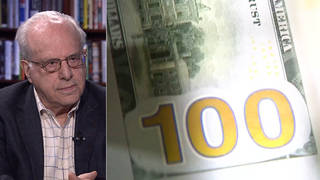
Guests
- Ian WilliamsU.N. correspondent for The Nation and author of several books, including Rum: A Social and Sociable History of the Real Spirit of 1776.
To mark the start of the holiday season, Ian Williams talks about his new book on the history of rum. He writes about how rum and revolution have been associated together for centuries. Rum is “the global spirit with its warm beating heart in the Caribbean,” the one factor that is shared by all the cultures of the region, and drunk by the descendants of those who were enslaved to produce it. [includes rush transcript]
Transcript
AMY GOODMAN: Ian Williams, we’re going to switch gears, as we move into this holiday weekend, and talk about, well, your latest book. Kieran is going to bring in some of the product that we’re talking about. But your book is called Rum: A Social and Sociable History of the Real Spirit of 1776. Why did you spend your last years writing about rum? And what have you got on the table here?
IAN WILLIAMS: Well, this is the fun one. This is contraband, people. This is Havana Club, seven-year-old, that Bacardi and the U.S. Congress have spent years trying to stamp out. And it’s very popular in Europe, because people like to think they’re cutting a snook at Uncle Sam every time they have a drink. And this is Mount Gay from Barbados, which is where, I discovered, rum was founded — was discovered.
My revelation on this was based on being in Martinique on another project and suddenly realizing that in the 18th century, the Caribbean was the equivalent to the Persian Gulf. This is where hundreds of thousands of people went and died, because it was the source of liquid wealth. It was rum and sugar that basically developed New England, developed the Atlantic Seaboard and gave Britain its commercial prominence in the 18th century. It pioneered — it was the money from rum and sugar that produced the British national debt, which until George Bush came along, was the biggest in the history of the world. So they financed their wars with the profits of the sugar.
JUAN GONZALEZ: Your book suggests that the American Revolution was more about rum than it was about tea.
IAN WILLIAMS: Indisputable. I mean, you know, look, not even the British fight wars about Earl Grey. The tea was actually duty-free. Samuel Adams and the others were smugglers that — the Boston Tea Party was a bunch of smugglers who had warehouses full of smuggled tea that was about to be undercut by duty-free tea that the East India Company was bringing in. That’s why they threw it overboard, because they couldn’t rely on the good citizens of Boston to be patriotic enough to pay extra for the tea they had in the warehouses.
And the real issue was that the Americans had been trading with the French for the whole of the hundred years of wars between Britain and France, about Canada and the French presence there. And they didn’t want to pay taxes on the molasses, which they used to make rum.
And think of what New England did with that rum. They bought slaves with it. They used it to clear the Indians out of the West. They drank an awful lot of it themselves. It was a huge motor of the economy in New England, because the New Englanders took timber and cod down to the Caribbean and traded that for the molasses, which then they made into rum, which then they took to buy slaves with, and took the slaves to the Southern colonies and to the Caribbean. It was a pretty sort of vicious trade, but New England was built up on it. There’s not many actual resources in Massachusetts, you know. You can’t grow many things. There’s no mines. There’s no oil. There were just fish.
AMY GOODMAN: Ian, you write rum was used by the colonists to clear Native American tribes and to buy slaves. How did they clear the tribes?
IAN WILLIAMS: Well, basically, they made them dependent, because in the early days, the most important part was the fur trade. And, you know, the Indians would come in, and they would buy — they would bring their furs in and get, you know, blankets, food, whatever goods they needed. But rum was like cocaine. They wanted the rum badly.
So, first of all, they hunted out and actually clear cut sort of, in a sense — they trapped out all of the animals, so they’d get more and more rum. And the rum had devastating social effects. I mean, this was a really potent substance unleashed on people who were not used to it. And the Indians sort of — apparently it was an alibi for a murder if you were drunk, which I don’t think would go down well in most courts nowadays. But the Indians, it was sort of almost a spiritual thing. They actually held people down and forced more rum down them. It really ruined the societies. It devastated them.
JUAN GONZALEZ: So, in other words, that famous scene in the classic Marlon Brando movie, Burn, where Jose Dolores, the rebel slave, introduces Brando, who’s like a 18th century British CIA agent, in essence, to rum, and he introduces him to whiskey. It is apocryphal, in other words, that —
IAN WILLIAMS: Well, they’re not apocryphal. It’s a brilliant film. I mean, more people should see that. But it shows the importance of it at the time of what was going on. And, I mean, this is the other part of rum’s history. I mean, I’m enjoying this stuff, but when you think of what sugar and rum, and about the slave rebellions in Haiti and Guadalupe — I mean, the story of Haiti, it’s just worth reading over and over again, what happened then.
AMY GOODMAN: Talk about it.
IAN WILLIAMS: Well, when the slaves revolted, basically this was almost like Cambodia. First of all, the French Revolution freed the slaves. And then, Napoleon tried to reintroduce slavery. And the only reason that Haiti had stayed French was that it was the black and slave-led armies which had fought the British and defeated them all that period. And they defended it for the Revolution. And then Napoleon came back in and tried to reintroduce slavery, and they revolted against that.
And, you know, basically for 20 or 30 years, the island was devastated with wars and counter-wars. And I think the most touching one is in Guadalupe, which is, I’ve discovered in the course of this and it should be better know — at one point, when Napoleon came in to reintroduce the slave system, a mixed regiment of white sans-culottes who came out from Paris, the half-breed sort of middle class blacks and the slaves actually blew themselves up in Guadalupe rather than surrender to slavery. Now, that’s one of the epic stories of human freedom. It’s just not told. And, you know, it’s another part of that story of rum, which — it got so fascinating. And I must say that I drank a lot more rum than was strictly necessary for the research. But it was fun while I was doing it.
JUAN GONZALEZ: Speaking of rum and revolution, you also get — obviously you talk about rum being the most popular spirit in the world, but you — one of the most famous of the rum companies, obviously, is Bacardi, and you deal a lot with the role of Bacardi in relationship to politics and revolution.
IAN WILLIAMS: Well, Bacardi — I mean, I didn’t know until I had started researching this, and I don’t think either Castro or Bacardi have advertised this, but Bacardi actually sent checks up to Castro and Che in the Sierra Maestra to finance their rebellion against Batista.
JUAN GONZALEZ: But you also say that Bacardi’s origins are actually in Jamaica originally?
IAN WILLIAMS: Well, no. It was a Jamaican — as far as I can tell, it was a Jamaican distiller who, after they abolished slavery in Jamaica in the 1830s in the British Empire, he moved to Cuba because they still had slaves there, the sugar was cheaper, the plantations were functioning, and set up a distillery, which, it looks like, the Bacardi family actually inherited, including the still itself. And the Bacardi family were actually rebels at one point. But at one point, sort of commercial expertise outweighs their politics. It was a tot of Bacardi rum which revived the crown prince of Spain from his deathbed, and they got the royal appointment for it.
I’ve been pushing, half-facetiously, rum as a sort of specific for avian flu. Tamiflu, double blind tests show that it’s not very effective, has bad side effects. Now, rum, 300 years of tradition in fighting colds and flu, and the side effects are entirely benign in my experience.
AMY GOODMAN: And so, Havana Club today, its relation to the embargo?
IAN WILLIAMS: Well, what happened was that America — because Bacardi basically controls the Florida delegation to Washington, Bacardi passed special — basically every time they’ve lost in court, they’ve had a clause put into legislation in Washington to get it all back again. And they are ignoring the World Trade Organization. They have claimed the trademark on Havana Club from Cuba, which is recognized in the rest of the world. And they’re actually trying to make Havana Club here. Even there, it’s very dubious legally. And you can’t import Cuban rum into the United States. It’s because of the embargo.
But in the rest of Europe, Pernod Ricard, in partnership with the Cubans, has been really selling it. It’s one of the most popular rums and drinks in Europe. And a lot of that is people wanting to sort of give the finger to Uncle Sam, because they know. But Fidel was not exactly honest on this one. When everything crashed, he was telling the Cubans they should stop drinking rum, it was bad for them, but the real reason was they couldn’t get enough to supply the world markets.
AMY GOODMAN: What most surprised you about writing Rum, since you knew a lot about it before you started?
IAN WILLIAMS: I think it was just to see how it had grown and just how big the rum and sugar trade was. You know, it’s these things that you take for granted. You take for granted that New England is industrialized or that, you know, Britain was ruling the world.
JUAN GONZALEZ: This was the oil of the —
IAN WILLIAMS: This was the oil of the 18th century, yes. It was liquidity, in every sense.
AMY GOODMAN: And in a nutshell, how it’s made?
IAN WILLIAMS: What you do, you take sugarcane, the juices from the sugarcane or the molasses left over after you’ve crystallized it — either will do — and you distill it. You ferment it, and then you distill it. And that gives a much more complex sort of set of mixture in the distillation than you get from whiskey or brandy. The secret is the aging. Rum, more than anything else, it has to be aged in wood over a sort of reasonable period of time for it to be really good.
JUAN GONZALEZ: And what does the wood do?
IAN WILLIAMS: Well, it lets oxygen in and out, but also, I mean, all these brown spirits — this is something else I had never really thought about before — all these brown spirits are brown because of the oak that they’re kept in. It sort of takes the oak and the tannins. And when you have a really bad hangover, you have to remember that the tannins are what they use to tan leather, and that’s what the drinks take out of the wood. But they used to think that you put them on a sea journey. That’s what improved it. And then they realized that it wasn’t the sea journey, it was storing it in the wooden casks, which made the difference.
AMY GOODMAN: Well, Ian Williams, I want to thank you for writing the book. I don’t think we’re going to take one of these bottles and crash it over, baptize, our new soundboard, but I thank you for talking about the social and sociable history of the real spirit of 1776. The book is called Rum.












Media Options